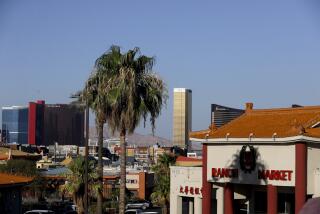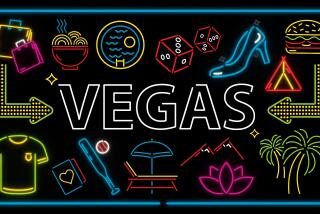Las Vegas, the chameleon city
- Share via
THE CLOSING of the Stardust Resort and Casino on Wednesday and its transformation into Echelon Place, an upscale mega-property replete with a hotel, condominiums and other amenities, is the latest chapter in the never-ending reinvention of Las Vegas. Like no other city in the United States — indeed the world — Las Vegas creates itself anew in the wink of an eye. That malleability is one major component of the alchemy of the place but by no means the only reason for the remarkable rebirth of what was once the nation’s “Sin City.”
In two decades, Las Vegas has gone from gaming to tourism to entertainment. In the same span, the metropolitan area nearly quadrupled in population, as Las Vegas took a primary place in the top tier of U.S. cities. Most amazing, this evolution occurred as gaming spread throughout the nation after passage of the Indian Gaming Regulatory Act in 1988. The city that everybody has long loved to deride must be doing something right.
The transition has been rapid. Two generations ago, modern Las Vegas was born with the sophisticated cachet of Sin City for the nightclub set, which quickly degenerated into kitsch. Only a generation ago, in the late 1970s and early 1980s, the city retained its stigma as the sleazy home of tawdry sex and mobsters. Las Vegas seemed played out, passe, soon to be cast aside as a flimsy relic of a laced-up morality. One of the last of the first generation of Las Vegas hotels, the Stardust had its own checkered history. It was the scene of the convoluted events of the book and movie “Casino,” the story of the last great mob scandal in Las Vegas. The Boyd Gaming Corp. acquired the property after the body of Tony Spilotro, the onetime mob boss of Las Vegas, turned up in Indiana, paving the way for the property’s transformation. (See Page M4)Las Vegas the city has made a living out of reinventing itself. Its consistent reinvention, once scorned as flimsy and fraudulent, shaped its trajectory from periphery to mainstream and has become a much-envied trait.
Las Vegas’ physical limitations forced the community to bend to the will of whatever enterprise would generate revenues. This submission to the inevitability of change gave Las Vegas a fluidity, a way around the rules of midcentury America, that locals have learned to treasure. The city learned that its shape was always transitory, always flexible, not only because it responded to the emotions of mainstream culture but also because the forces behind the city were on the borders of legality. Even in moments of great success, Las Vegas had a powerful sense of impermanence, a strong intuition that whatever ruled today might well not tomorrow.
From its roots in sin, Las Vegas has grown into the most malleable tourist destination on the planet. It makes the visitor, however ordinary, the center of the story, holding up a figurative mirror and asking: “What do you want to be, and what will you pay to be it?” Who you were or what you were yesterday makes little difference. All tourist towns reflect desire — but Las Vegas anticipates it.
To the surprise of many, entertainment, not gaming, is redefining Las Vegas this time. Gambling dollars grease the wheels, but since 1996, gambling has accounted for less than half the money spent by visitors to Vegas, according to state economic data. The city offers the middle-class visitor a luxury experience at a middle-class price. It also can cater to the most uncompromising of expense accounts. As the New York Times recently reported, this town that was once synonymous with cheap buffets led the charge (along with New York) into the era of the $40 entree.
With more than 40 million visitors annually, the shoulder season is short.
Entertainment has created a city like many others and simultaneously apart. Las Vegas is equal parts Washington (a transient place where everyone is on the make), Los Angeles or Miami (more and more conversations are in Spanish), Phoenix (almost 25% of the population is retired, and medical care has become a huge industry), Detroit of the old days (home of a vocal and powerful semi-skilled unionized workforce) and New Orleans before Katrina, (as Etta James still sings, “Care forgot, where everybody parties a lot.”). And Las Vegas is newer, less structured, more vital, with fewer rules and wider degrees of what constitutes normal.
Along the way and almost by accident, Las Vegas has become the place where the 21st century begins, the first spectacle of the postmodern world. In this incarnation, the old pariah becomes the model, the colony of everywhere, the colonizer of its former masters. Old Nevada allowed people to come and cast off their sins. When professional prizefighting was illegal in every state in the union but one, Nevada filled the void with title bouts.
This once dubious trait — liberation from the burden of sin — is a virtue in the post-industrial world. Las Vegas was the first city devoted to the consumption of entertainment, and to be first at anything in a fluid culture is to have a claim on being significant. It offers an economic model for cities, states and regions looking to create their own economic panacea — even as they hold their noses.
Las Vegas as spectacle has become the rhythm of America, combining holidays, rituals and ceremonials: Martin Luther King Jr. Day, the Super Bowl, Chinese New Year, Presidents Day weekend, March Madness and especially the Final Four, Memorial Day, the NBA finals, Fourth of July, Labor Day, the NFL season, the World Series, Halloween, Thanksgiving, Christmas and New Year’s Eve. Anybody’s holiday or event will do. Every night can be New Year’s Eve if you want it to be.
Doomsayers all predict the demise of Las Vegas, arguing that the appetite it satisfies will diminish or that so many other places will offer Las Vegas-style amenities that the city will lose its singular luster. But if Las Vegas’ history is any guide, the city’s ability to respond to cultural change will keep it vigorous. Since the legalization of gambling in Nevada in 1931, Las Vegas has provided Americans with what they weren’t supposed to have at home and make whatever it was permissible if not flat-out OK. This sleight of hand was a neat trick, accomplished by the city’s fundamental pliability.
In Las Vegas, ordinary people feel special, and people who feel they are special can be catered to in a manner that suits their self-indulgence. Las Vegas anticipated the transformation of American culture not out of innate savvy but as a result of a lack of other options for the city. The reinvention of American culture as purely the self — it’s all about you — catapulted Las Vegas to prominence. The city took sin and made it a choice, a sometimes ambiguous choice that many in U.S. society, from the privileged to the ordinary, couldn’t handle, but choice nonetheless. Combined with a visionary approach to experience that melded Hollywood and Americans’ taste for comfort and self-deception, Las Vegas grew into the last American frontier city, as foreign at times as Prague but as quintessential as Peoria.
In Las Vegas, you can choose your fantasy. In the rest of America, you don’t always get to pick.
More to Read
Sign up for Essential California
The most important California stories and recommendations in your inbox every morning.
You may occasionally receive promotional content from the Los Angeles Times.










